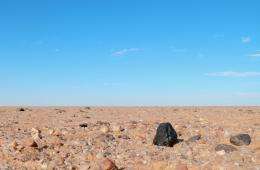Almahata Sitta meteorites could come from triple asteroid mash-up

(PhysOrg.com) -- Analysis of fragments of the Almahata Sitta meteorite, which landed in Sudan in 2008, has shown that the parent asteroid was probably formed through collisions of three different types of asteroids. The meteorites are of particular interest because they contain material both primitive and evolved types of asteroids. The results will be presented at the EPSC-DPS Joint Meeting 2011 in Nantes, France, by Dr. Julie Gayon-Markt on Friday 7th October.
The meteorites are fragments of the asteroid 2008 TC3, which impacted the Earth exactly three years ago on 7th October 2008. More than 600 fragments were collected from the Nubian Desert in Sudan. They are collectively known as Almahata Sitta, which is Arabic for “Station Six”, a train station between Wadi Halfa and Khartoum near where the fragments were found. The impact was historic because it was the first time that an asteroid was observed in space and tracked as it descended through the Earth’s atmosphere.
“Because falls of meteorites of different types are rare, the question of the origin of an asteroid harbouring both primitive and evolved characteristics is a challenging and intriguing problem,” said Gayon-Markt. “Our recent studies of the dynamics and spectroscopy of asteroids in the main asteroid belt shed light on the origin of the Almahata Sitta fragments. We show that the Nysa-Polana asteroid family, located in the inner Main Belt is a very good candidate for the origin of 2008TC3.”
Primitive asteroids, which are relatively unchanged since the birth of the Solar System, contain high proportions of hydrated minerals and organic materials. However, many other asteroids have undergone heating at some point, probably through the decay of radioactive materials, and the molten magma has separated into an iron core surrounded by a rocky mantle.
The Nysa-Polana family is divided into three different types: relatively rare B-type asteroids, which are primitive remnants of the early Solar System, stony S-type asteroids and intermediate X-type asteroids. Both S-type and X-type asteroids have undergone thermal evolution in their past. The spectral characteristics of all these three types are found in the Almahata Sitta fragments. The Nysa-Polana family is located in the inner Main Asteroid Belt and has a low orbital inclination relative to the ecliptic plane, which corresponds to the low-inclination of 2008TC3 during its journey to Earth.
The study led by Gayon-Markt suggests that 2008TC3 formed from the impact of an S-type object in the inner Main Asteroid belt with a B-type object from the Nysa-Polana family, followed by a second impact with an X-type asteroid of the Nysa-Polana.
“Around seventy to eighty percent of the Almahata Sitta fragments are what we call ureilites. Although ureilites show both primitive and evolved characteristics, their spectra in visible light are very similar to B-type primitive objects. The remaining twenty to thirty percent of the Almahata Sitta fragments gather two other kinds of meteorites which are linked to S-type and X-type asteroids. A workable explanation for how asteroid 2008TC3 could have formed involves low velocity collisions between these asteroid fragments of very different mineralogies,” said Gayon-Markt.
Provided by Europlanet



















